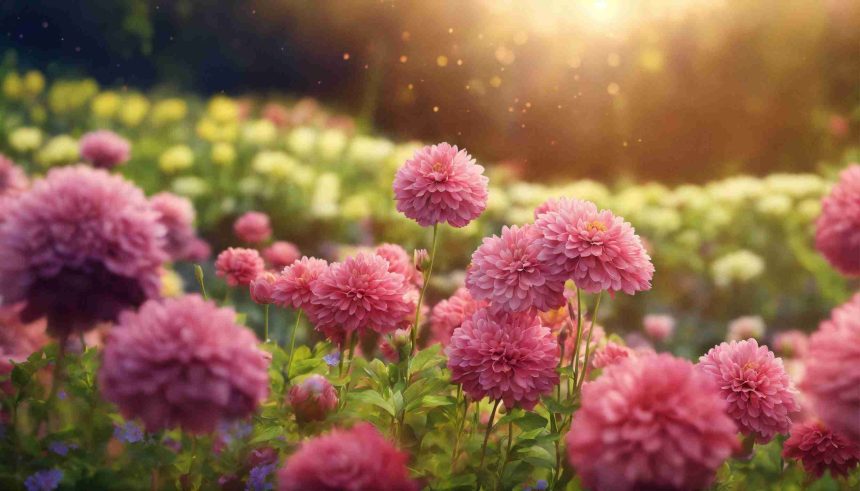Chive blossom vinegar is a delightful, easy-to-make artisanal vinegar with a mild oniony flavor. The pretty purple chive blossoms add subtle color and flavor that enhances all kinds of recipes. Read on to learn all about using these delicate flowers to craft your own infused vinegar at home.
An Introduction to Chives and Their Blossoms
Chives are a popular herb grown in home gardens, prized for the grass-like leaves that lend a light onion aroma and taste. The plant produces dense clusters of purple flowers on long thin stems in spring.
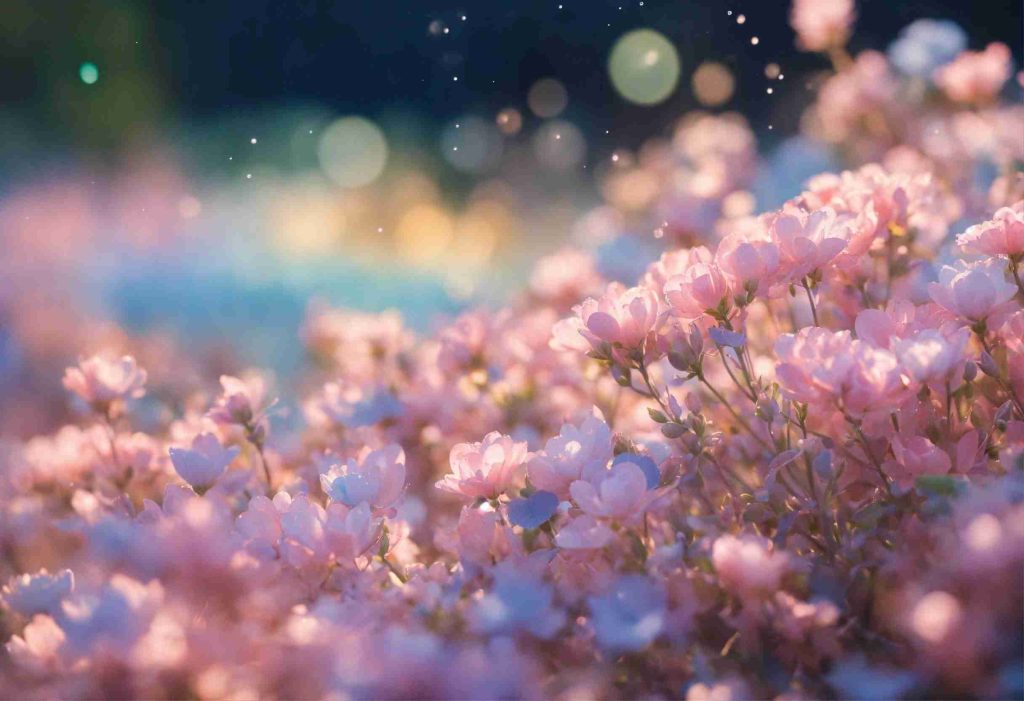
These mild onion-flavored flowers have many uses beyond just admiring them in the garden:
- Use fresh blossoms as a tasty edible garnish in salads, soups, omelets, pasta, and more
- Dry or freeze chive blossoms to preserve them for off-season use
- Infuse vinegar or oil with the blossoms to impart flavor
- Enjoy them straight from the garden as a snack! Both the flowers and stems have a pleasant oniony taste
By picking some of the blooms to use in the kitchen or pantry before they go to seed, you can extend the productive season of your chive plants. And crafting chive blossom vinegar captures their essence to enhance recipes all year long.
How to Make Chive Blossom Vinegar
Making infused vinegar with chive blossoms is very simple. All you need is:
- Chive blossoms
- White or champagne vinegar
- Clean glass jar or bottle
Step 1. Harvest blossoms on a dry, sunny day when the flowers are newly opened. Gently rinse and thoroughly pat dry with paper towels. Remove any residual green bits from the base of the blossoms.
Step 2. Fill your jar about halfway with the fresh chive blossoms. Pour vinegar over the blossoms until the jar is full, leaving at least 1/2 inch headspace. Use a vinegar with a neutral flavor like distilled white or champagne so it won’t compete with the delicate chive essence.
Step 3. Cap the jar tightly and place away from direct light. Allow the blossoms to infuse the vinegar for 2-3 weeks, gently shaking or turning the jar every few days.
Step 4. After infusion, carefully strain out the blossoms through a fine mesh sieve lined with cheesecloth. Compost the blossoms.
Step 5. Pour the finished chive blossom vinegar into a clean bottle. Add fresh snipped chives or new blossoms if desired. Label with the type of vinegar and date.
The infused vinegar keeps well unrefrigerated for 6-12 months. Refrigerate for longer storage. Over time the flavor will continue to intensify.
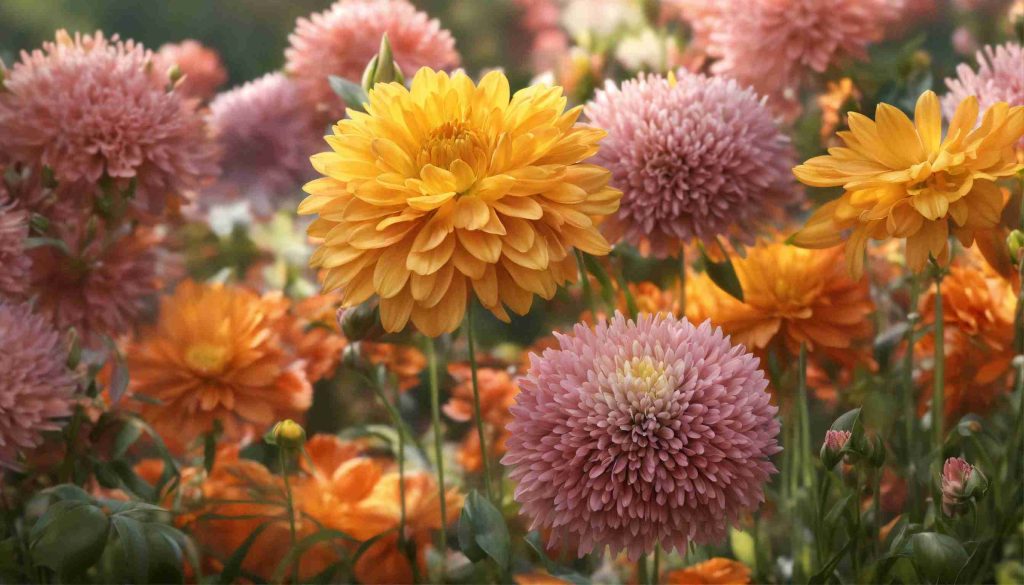
Now you can add a dash of your homemade flower-kissed vinegar to salads, roasted veggies, marinades, and more to elevate the flavors of your cooking all year long!
Growing Chives for Blossoms
Chives thrive with minimal care, making them an effortless herb for home gardens. Just be sure to situate them in a spot that offers:
- Full sun – Chives appreciate at least 6 hours of direct sunlight daily. Partial shade is tolerable but may reduce their productivity.
- Well-drained soil – Although chives tolerate most soil types, a loamy soil enriched with compost is ideal. Standing water can cause bulb rot.
- Even moisture – Established chive plants have relatively shallow roots. Consistent watering is key, especially in hotter climates. Drought causes stunted growth and poorer blossom production.
- Good air circulation – Space chive clumps 12-18 inches apart to allow for airflow and prevent mildew diseases.
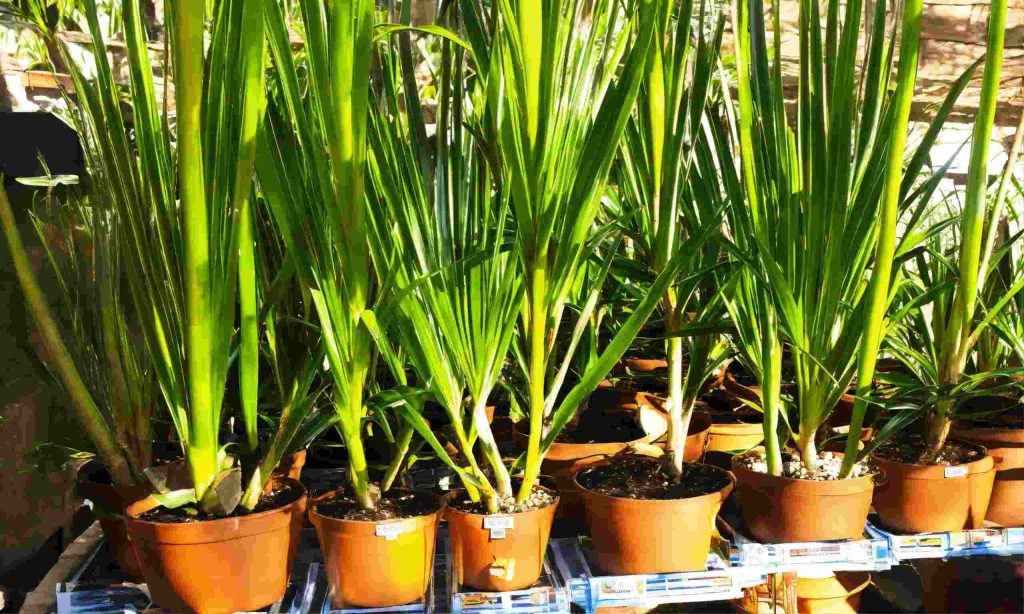
There are a few types of chives to grow. Common chives (Allium schoenoprasum) have the zingiest onion flavor. Garlic chives (Allium tuberosum) feature flatter leaves with a mild garlicky taste. Flowering times overlap for a continuous blossom harvest.
When to Plant Chives
You can begin sowing chive seeds indoors up to 2 months before the last expected frost. Transplant seedlings or divisions outdoors when daytime temperatures remain above 50°F.
How to Plant
- Chives grow from small bulblets or clumps divided from mature plants. Reputable nurseries carry bulblets bare root or potted.
- You can also start chives from seed either indoors or direct sown into the garden. Soak seeds for 24 hours before planting to speed germination.
- Plant the bulblets or tiny seedlings just deep enough to stand upright, about 1/2 to 1 inch below the surface. Space clumps 12-18 inches apart in rows or clusters.
Care Tips for Productive Plants
- Apply a balanced organic fertilizer or compost tea monthly throughout the growing season.
- Water chives consistently, especially during flowering and seed set.
- Clip leaf tops frequently to stimulate new growth. Always cut leaves at least an inch above the soil line.
- Divide congested clumps every 2-3 years after flowering finishes. Replant the divisions to refresh plants.
- Mulch plants in cold winter regions for added insulation if the ground freezes deeply. Remove mulch after the last hard frost date in spring.
When and How to Harvest Chive Blossoms
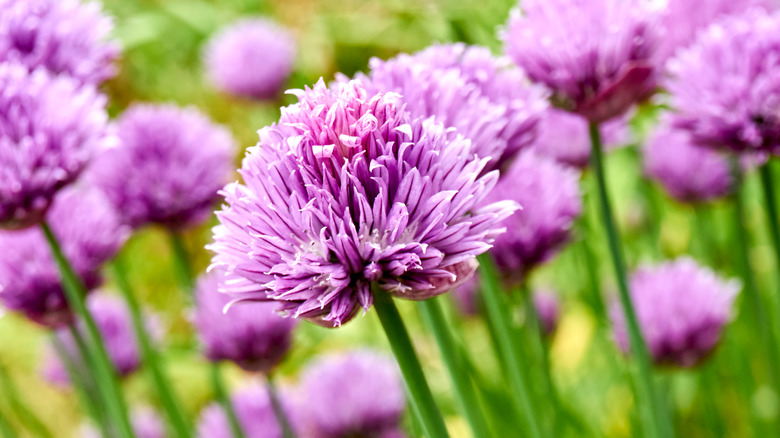
Depending on variety and growing conditions, flowering typically begins 4-6 weeks after spring growth resumes. Blossoms appear on long, thin scapes rising 6-12 inches above the grassy leaves over a 1-2 month period.
The violet flower buds lengthen into oval balls composed of dozens of tiny six-petaled blooms. Harvest chive blossoms when the flower heads reach full size but before individual blooms start opening. This is usually shortly after the buds first emerge from the protecting papery bract.
- Gently pinch or snip off flower heads at their base just above the top leaves. Be careful not to damage new buds lower on the developing stalk.
- Time harvests for mid morning on a sunny day when blossoms are fully open and dry.
- Float just-picked blossoms in a bowl of cool water and swish gently to rinse. Spread on a clean towel to dry thoroughly before use. Refrigerate in a paper bag or breathable container for 1-2 days maximum.
Leave some flowering stalks intact on plants to develop seeds for next year’s chives. As flowers fade, bulbils form in the umbels where petals attached to the scape. Let seeds mature and scatter back into the garden bed to propagate more chive plants.
How to Use Your Chive Blossom Vinegar

Home infused vinegars retain the subtle flavors and aromas of the blossoms. Chive flower vinegar brings out and enhances other ingredients rather than overpowering them.
Try using small amounts to brighten all kinds of dishes:
Vinaigrettes and Dressings: Whisk a tablespoon or two of the vinegar together with oils, mustard, herbs and seasonings for salads, chilled veggie sides, and slaws.
Marinades and Sauces: Deglaze a pan with a splash of the vinegar after cooking meat or poultry. Or add to marinades and barbecue sauces for a bit of sweet onion flavor.
Cooking Liquid: Add a dash of the infused vinegar to the cooking water for grains or legumes. Also try poaching fish or chicken with aromatic vegetables and chive blossom vinegar.
Pickling: The subtle onion notes work nicely as part of a brine for quick refrigerator pickles or fermented vegetables.
Beverages: Add a teaspoon or two to lemonade, iced tea, or cocktail mixes to round out the flavors.
The delicate chive blossom infusion shines when used as a background player rather than taking center stage. Let your imagination run wild dreaming up tasty ways to incorporate this home-crafted vinegar into your cooking!
Troubleshooting Chive Blossom Vinegar
Properly stored, infused vinegars will keep for a year or longer. But occasionally problems can arise:
Cloudy vinegar – This harmless cloudiness is caused by tiny particles of plant matter in the infusion. Strain again through a fresh coffee filter to clarify.
White film – Yeasts and acetobacter from blossoms can form a harmless film on the vinegar’s surface. Skim off and discard. Wipe rim clean before resealing infused vinegar.
Mold – Discard immediately if fuzzy mold colonizes the vinegar’s surface or floating debris. Safely compost unusable vinegar down the drain followed by hot water. Sterilize equipment before starting a new batch.
Off smells – Vinegar naturally develops more acidic aromas with long storage as acids intensify. Discard if smell becomes unpleasant or you notice rotten odors.
As long as infused vinegars smell pleasant, they are safe for consumption. Trust your nose to detect issues before tasting sketchy vinegar. When in doubt, pour it out!
More Flavored Vinegar Ideas
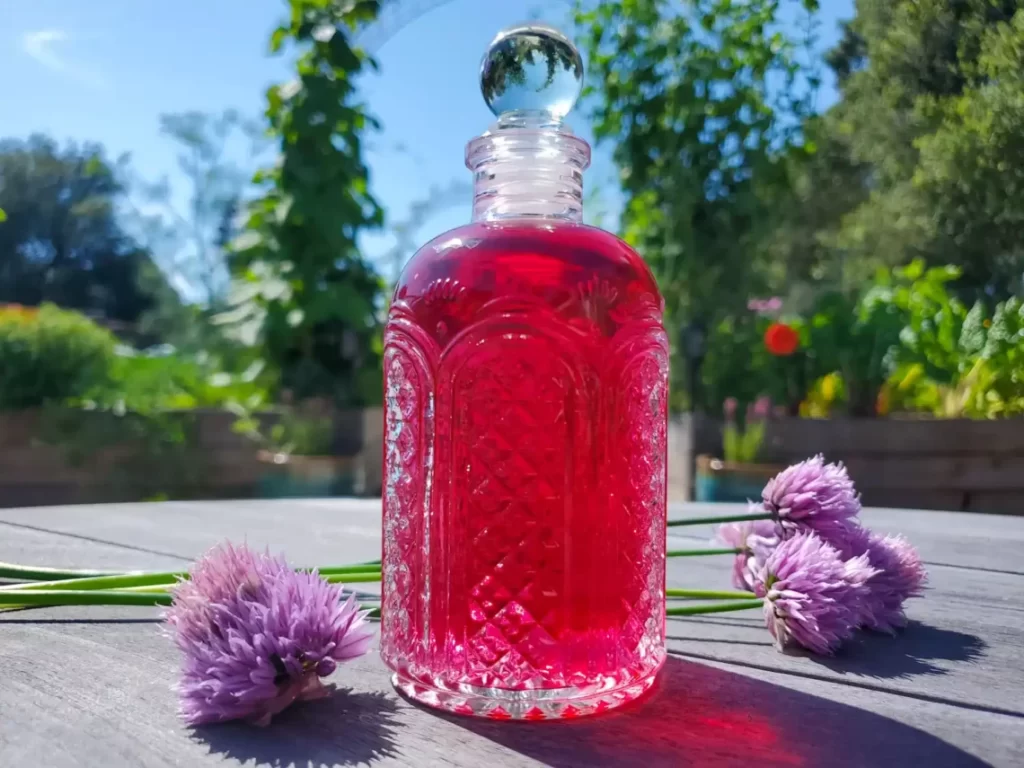
Once you master the process of infusing vinegars with chive blossoms, consider expanding your pantry collection with other garden herbs, fruits, and flowers:
- Garlic scapes
- Lemon thyme
- Rosemary
- Lavender
- Citrus peels
- Berries
- Rose petals
- Calendula petals
- Lilac blossoms
The ingredients you have on hand will vary by the seasons. Herb stems, vegetable peelings and other scraps that might otherwise get composted also often make marvelous vinegars.
Part of the delight in infusing your own vinegars is the creativity – playing with different flavor combinations that reflect the seasonality of your garden bounty. Label your creations carefully so you remember the provenance of special small-batch editions.
Over time you can amass quite the trove of unique hand-crafted vinegars to not only tantalize your tastebuds in the kitchen but also impress fellow foodie friends and family!
Companion Plants
| Carrots | Chives help repel carrot flies and deter insect pests, allowing carrots to grow better. |
| Tomatoes | Chives improve tomato growth and flavor when planted together. The chives deter aphids, mites, and other potential tomato pests. |
| Apples | Scattered among apple trees, chives help prevent apple scab disease. Their flowers also attract pollinators to benefit fruit set. |
| Grapes | Chives make great companions for grapes, driving away pests like Japanese beetles. |
| Roses | Onions and chives help protect roses against diseases and aphid damage when planted nearby. |
| Strawberries | Lettuces and chives enrich the soil, improve growth, and protect strawberry plants from slugs and snails. |
| Brassicas | Planting chives around cabbages, kale and other brassicas deters caterpillars. |
| Peas | Chives not only repel insects that may damage pea plants, but white flowering chives also attract beneficial pollinators. |
| Fruit Trees | Scatter chives around the base of fruit trees to improve their health and productivity. The blossoms draw pollinating insects. |
So interplanting chives among vegetables and fruits often increases yields and deters certain common garden pests. Their pretty flowers also invite beneficial pollinators!
Frequently Asked Questions About Chive Vinegar
Choose a high-quality vinegar with a neutral flavor profile like distilled white vinegar or champagne vinegar. This allows the delicate flavors of the chive blossoms to shine rather than compete with stronger tasting vinegars.
Loosely fill your jar about 1/3 to 1/2 full of just-picked chive blossom heads, lightly packed. More blossoms will result in a stronger infusion. You can always add more flowers to a batch later for an intensified flavor.
Plan on infusing blossoms 2-4 weeks. Check periodically after the first week. Go longer for a more intensely flavored vinegar. If using a delicate herb like chives, however, peak flavor could fade with over-infusion beyond 4 weeks. Trust your taste buds!
Properly stored in a cool cupboard away from light, infused vinegars will retain peak quality for around 6 months to a year. Refrigeration prolongs shelf life even longer – up to 2 years. The flavor mellows over time but remains usable.
It’s best to compost and discard the used plant material once you’ve strained out the infused vinegar. For food safety, you don’t want to introduce organisms from the damp blossoms into a new batch. Enjoy those chive flowers just once in your vinegar before sending them to the compost pile!
Final Thoughts
Crafting your own flavored culinary vinegars is both simple and extremely rewarding. With a jar, fresh chive blossoms, and basic white vinegar, you can easily capture the ephemeral beauty of these garden flowers into a unique delicacy. A few delicate blossoms yield this lively infusion brimming with gentle oniony essence – ready to brighten all your favorite recipes.
The entire process from planting to infusing to cooking teaches mindfulness and a appreciation for seasonality. As any gardener knows, nothing compares to the pride in enjoying foods you nurtured all the way from seed to table.
Let chive blossom vinegar be your gateway into further culinary experiments with herbs and edible flowers! The only limit is your creativity.
Read More
How to Dry Comfrey Leaves: Quick & Effective Methods


